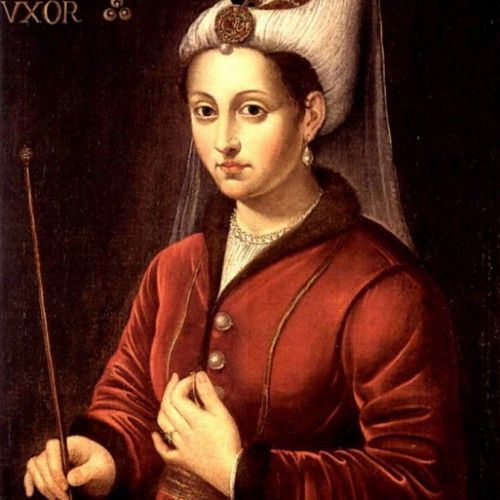Born in Ruthenia (now Rohatyn, Ukraine) to a Ruthenian Orthodox priest, she was captured by Crimean Tatars during a slave raid and eventually taken via the Crimean slave trade to Istanbul, the Ottoman capital. She entered the Imperial Harem where her name was changed to Hürrem, rose through the ranks and became the favourite of Sultan Suleiman. Breaking Ottoman tradition, he married Hürrem, making her his legal wife. Sultans had previously married only foreign free noble ladies. She was the first imperial consort to receive the title, created for her, to Haseki Sultan. Hürrem remained in the sultan’s court for the rest of her life, enjoying a close relationship with her husband, and having six children with him, including the future sultan, Selim II. Hürrem is the ancestor of all following sultans and currently living members of the Ottoman dynasty.
Hürrem died on 15 April 1558 due to an unknown illness. In the last years of her life she was in very poor health. It is said that the Sultan, in order not to disturb the peace of his wife during the course of her illness, ordered all the musical instruments in the palace to be burned. He did not leave Hurrem’s bed until the last day, when she died. The farewell dedications written by the Sultan to Haseki after her death, which have been preserved to the present day, demonstrated Suleiman’s love for Hürrem. She was buried in a domed mausoleum (türbe) decorated in exquisite Iznik tiles depicting the garden of paradise, perhaps in homage to her smiling and joyful nature.[39] Her mausoleum is adjacent to Suleiman’s, a more somber, domed structure, at the courtyard of the Süleymaniye Mosque. (Wikipedia)
Historians described an ancient tribe of Roxolani that dwelt in the area near the Dnieper River. The Wiki article has the following information: “George Vernadsky theorized about the association of Rus and Alans. He claimed that Ruxs in Alanic means “radiant light”, thus the ethnonym Roxolani could be understood as “bright Alans”. He theorized that the name Roxolani is a combination of two separate tribal names: the Rus and the Alans“.
Could the fact that Hurrem Sultan was known by the name Roxelana be a confirmation of Vernadsky’s theory?
If it is so, it means that the Normanism theory with its Ruric story is most likely a forgery of history by Moscow and the Anti-Normanism proponents have been correct all along.
Below is a great Timeline documentary about her, Suleiman, and the harem of the Ottoman Empire. A lot of what people think they know about the harem was not true (like orgies and the like):
The “Gardariki, Ukraine” e-book has more little-known facts and insights into the Rus’ origin.
